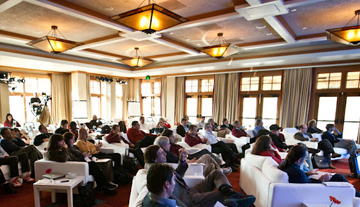Events

Solve For X started with an experimental event in February 2012. For three days, forty-six scientists, entrepreneurs and innovators from around the world came together to discuss and debate radical solutions to some really big problems using breakthrough technologies.
Learn more in our blog post and these sample videos for more context.
Since our first event, we have added some wonderful partners and opened up the community here to anyone interested --- welcome!!
Annual Solve for X Event
On February 6-8, 2013 we hosted our second annual Solve for X Event. The Solve for X gathering is a place to celebrate a concept we champion internally at Google and we believe will inspire many others: technology moonshots. These are efforts that take on a global-scale problem, define a radical solution to that problem, and involve some form of breakthrough technology that could actually make it happen. Moonshots live in the gray area between audacious projects and pure science fiction; they are 10x improvement, not a 10% gain.
At least a few times a year, we hope that people will take a few hours or a day or two out of their busy schedules to dare to push the boundaries and consider moonshot approaches to some of the world’s many unresolved challenges. Solve for X isn’t about developing a new business line or building an investment portfolio. Rather, it aims to be a forum where technology-based moonshot thinking is practiced, celebrated and amplified.
Event Format: Exploration Sesssions
- Three back-to-back 12-minute talks: Speakers share their vision of how a breakthrough technology can be applied to a huge problem to radically improve the world. Each speaker’s 10-12 minute talk describes in some detail the three things that define a moonshot: a huge problem, a radical solution, and a breakthrough technology that makes the solution feasible.
- Small Group Brainstorming: After the series of talks, event attendees break into small table groups of 5-10 people to brainstorm and contribute ideas, suggestions and critique that should both evolve and test these visions. Audience size permitting, we try to have two different brainstorm tables per talk. The brainstorming sessions last 15-30 minutes depending on how much time is available. It's important to note the speaker does not join the brainstorm group that is focused on their talk, but should be available for questions on an as needed basis. We do this to allow for genuine brainstorming as opposed to a one-to-many debate or Q&A with the speaker.
- Report Back: Each breakout group briefly reports back post-brainstorming. Ask someone to be the scribe so there is a record of the ideas, suggestions and critique generated by the brainstorm, but avoid attributing comments to specific people, as this may inhibit an open discussion. Afterward, post both the talk video and brainstorm notes on SolveforX.com to start the online conversation.
Partner Events: Solve for X on Tour
We will be taking Solve for X on the road to bring Solve for X style programming to events around the world. For our first stop, we’re headed to Arizona State University for the Center for Science and the Imagination’s Emerge Conference.
Solve for X @ School: An Experiment
We’re now piloting Solve for X programming in schools. A talented group of middle school students and teachers in Minnesota used the Solve for X framework to create a hands-on interactive STEM experience in the classroom. Over the course of a few weeks, students used the Solve for X venn diagram to select a huge problem in the world, and then propose solutions that rely on breakthrough technology. Watch the video highlights here.
We hope other educators will experiment with Solve for X in the classroom. If you do, please let the community know by posting project highlights and learnings on our G+ page and emailing us at solveforx@google.com.
< Organizations we work with Team and Project History >